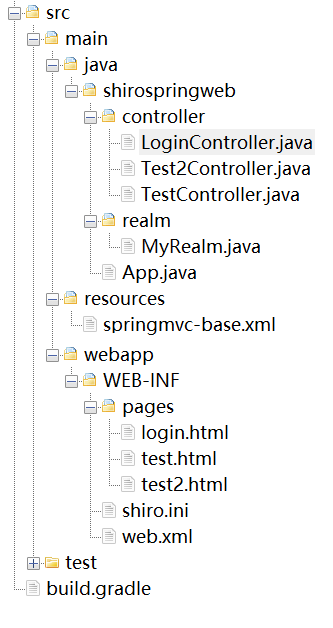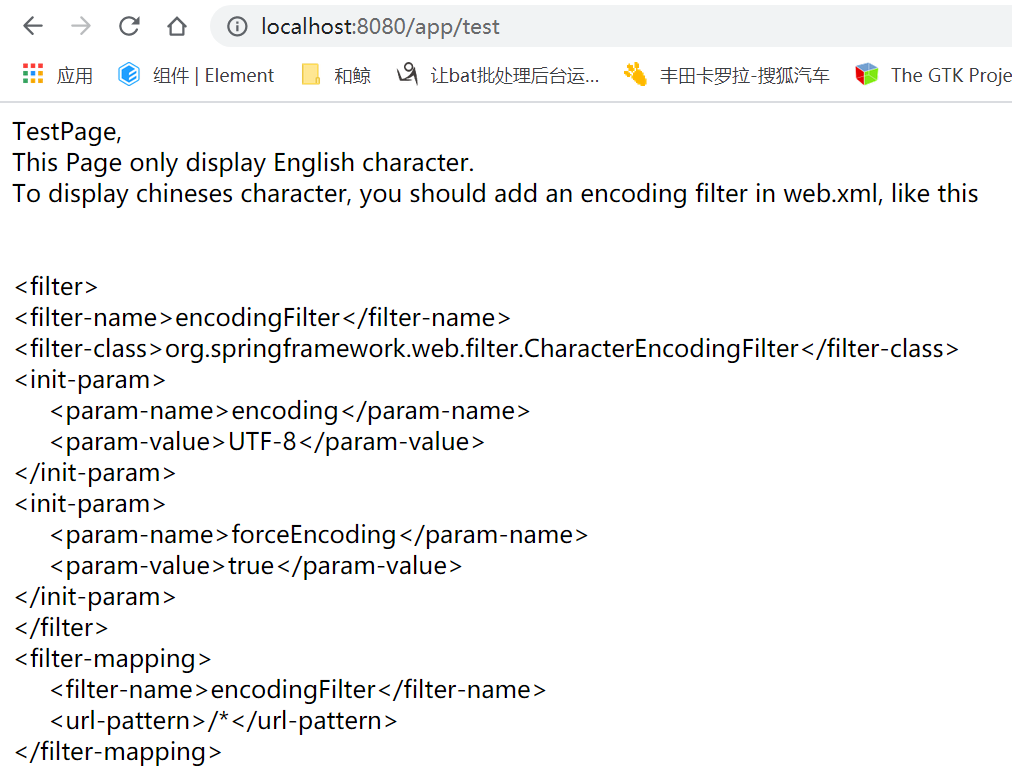想要整合Shiro和springmvc,在网上找了很多例子,感觉都有一点复杂。所以就自己写了一个最简单整合项目,记录在这里以备后面查看。
这个例子包含如下三个部分:
1.简单的页面
2.shiro配置
3.springmvc配置
shiro可以直接和spring整合,但是这样需要单独配置spring用于整合shiro,在配置springmvc。配置文件看起来乱七八糟的。所以这里就shiro不采用spring来管理。因此这里的整合类似 shiro + servlet + springmvc。这样配置相对简单好理解。但也是最简单的配置,只能用于学习,用在实际项目中,还得改写。
下面是项目结构图(realm那个文件夹可有可没有,只是如果删除了,就需要将shiro.ini文件中 myrealm = shirospringweb.realm xxxx 那行删除掉)

下面是具体步骤
(1).添加依赖
既然是简单,那引用也是最少的,具体如下
dependencies {
// Use JUnit Jupiter for testing.
testImplementation "org.junit.jupiter:junit-jupiter:5.7.1"
// This dependency is used by the application.
implementation "com.google.guava:guava:30.1-jre"
// ++ Adding Spring dependencies
implementation "org.springframework:spring-context:5.3.9"
implementation "org.springframework:spring-webmvc:5.3.9"
// ++ Using Servlet for SpringMvc
implementation "javax.servlet:javax.servlet-api:4.0.1"
// ++ Using shiro-web
implementation "org.apache.shiro:shiro-web:1.7.1"
}
其中前面两个是建立项目自带的,所以只需要引用后面的四个包就可以咯
(2).Servlet中配置Shiro
在servlet整合shiro,只需要在web.xml中引用shiro的上下文监听器(读取shiro配置文件),并配置shiro过滤器即可,具体如下:
<!-- Shiro直接拦截,不经过spring --> <listener> <listener-class>org.apache.shiro.web.env.EnvironmentLoaderListener</listener-class> </listener> <!-- 对应filter--> <filter> <filter-name>shiroFilter</filter-name> <filter-class>org.apache.shiro.web.servlet.ShiroFilter</filter-class> </filter> <!-- filter Mapping--> <filter-mapping> <filter-name>shiroFilter</filter-name> <url-pattern>/*</url-pattern> </filter-mapping>
在web.xml中配置好shiro后,需要在WEB-INF文件夹下书写shiro.ini的配置文件,具体如下
[main] authc.loginUrl = /login authc.usernameParam = username authc.passwordParam = password authc.successUrl = / authc.failureKeyAttribute = shiroLoginFailure logout.redirectUrl = / myrealm = shirospringweb.realm.MyRealm [users] liang = 123, role1 wang = 123, role2 [urls] / = anon /test = anon /test2 = authc /login = authc /logout = logout /** = anon
这样shiro就可以配合servlet工作了
(3).配置springMVC
最简单springmvc的配置,只需要配置一个DispatcherServlet,并在其配置文件(resources/springmvc-base.xml)中打开包扫描,就好了,具体如下:
<!-- 配置SpringMVC --> <servlet> <servlet-name>springServlet</servlet-name> <servlet-class>org.springframework.web.servlet.DispatcherServlet</servlet-class> <init-param> <param-name>contextConfigLocation</param-name> <param-value>classpath:springmvc-base.xml</param-value> </init-param> </servlet> <!-- 对应servlet mapping --> <servlet-mapping> <servlet-name>springServlet</servlet-name> <url-pattern>/*</url-pattern> </servlet-mapping>
resources/springmvc-base.xml的配置文件如下(主要是打开包扫描和注解驱动):
<?xml version="1.0" encoding="utf-8"?>
<beans xmlns="http://www.springframework.org/schema/beans"
xmlns:xsi="http://www.w3.org/2001/XMLSchema-instance"
xmlns:context="http://www.springframework.org/schema/context"
xmlns:mvc="http://www.springframework.org/schema/mvc"
xmlns:aop="http://www.springframework.org/schema/aop"
xsi:schemaLocation="http://www.springframework.org/schema/beans http://www.springframework.org/schema/beans/spring-beans.xsd
http://www.springframework.org/schema/context http://www.springframework.org/schema/context/spring-context-4.1.xsd
http://www.springframework.org/schema/mvc http://www.springframework.org/schema/mvc/spring-mvc-4.1.xsd
http://www.springframework.org/schema/aop http://www.springframework.org/schema/aop/spring-aop.xsd">
<context:component-scan base-package="shirospringweb.controller"/>
<mvc:annotation-driven />
<!-- 用来处理当 DispatcherServlet 拦截全部请求的时候,它在RequestHandler处捡出静态资源的请求 -->
<mvc:default-servlet-handler />
</beans>
然后书写上面shiro配置文件中的对应controller和前端页面就可以了。具体如下:
3.1 TestController 及其页面
TestController的代码,如下所示
package shirospringweb.controller;
import org.springframework.stereotype.Controller;
import org.springframework.web.bind.annotation.RequestMapping;
@Controller
public class TestController{
@RequestMapping("/test")
public String testPage(){
return "WEB-INF/pages/test.html";
}
}
对应前端页面,如下所示(别看他挺多的样子其实啥也没有,这里主要是将了一个在springmvc页面中也是中文的配置,可以当做没看见)
<html> <head> <title>TestPage</title> </head> <body> TestPage, <br/> This Page only display English character. <br /> To display chineses character, you should add an encoding filter in web.xml, like this <br /> <br /> <br /> <filter><br /> <filter-name>encodingFilter</filter-name><br /> <filter-class>org.springframework.web.filter.CharacterEncodingFilter</filter-class><br /> <init-param><br /> <param-name>encoding</param-name><br /> <param-value>UTF-8</param-value><br /> </init-param><br /> <init-param><br /> <param-name>forceEncoding</param-name><br /> <param-value>true</param-value><br /> </init-param><br /> </filter><br /> <filter-mapping><br /> <filter-name>encodingFilter</filter-name><br /> <url-pattern>/*</url-pattern><br /> </filter-mapping><br /> </body> </html>
3.2 Test2Controller 及其页面
Test2Controller的代码
package shirospringweb.controller;
import org.springframework.stereotype.Controller;
import org.springframework.web.bind.annotation.RequestMapping;
@Controller
public class Test2Controller {
@RequestMapping("/test2")
public String getTest2Page(){
return "WEB-INF/pages/test2.html";
}
}
其对应的界面如下:
<html> <head> Test 2 Page </head> <body> This is the test 2 page <br/> (Can not display chinese Character, more information <a href="/app/test" rel="external nofollow" >click here</a>) </body> </html>
3.3 LoginController 及其对应的界面
LoginController的代码
package shirospringweb.controller;
import org.springframework.stereotype.Controller;
import org.springframework.web.bind.annotation.RequestMapping;
@Controller
public class LoginController {
@RequestMapping("/login")
public String getLogin(){
return "WEB-INF/pages/login.html";
}
}
其对应的登录界面
<html> <head>Login Page</head> <body> This is Login Page With No Chinese Character <br> <form action="/app/login" method="POST"> username : <input name="username" /><br/> password : <input name="password" /><br/> <input type="submit" value="LOGIN"/> </form> </body> </html>
好了,代码到这儿完事儿了,下面是运行的效果图
(4).运行效果
4.1 首先访问/app/test页面可以访问到(shiro未拦截)
页面如下

4.2 其实访问/app/test2需要登录,登录后需要后跳转(可能需要访问两次,有一次请求URL会带参数,这个shiro会报错,这是shiro的问题,可以百度解决)具体如下:

登录后跳转

访问/logout会退出到主页面,这个就不截图了
结束了
到此这篇关于shiro 与 SpringMVC的整合完美示例的文章就介绍到这了,更多相关shiro 整合 SpringMVC 内容请搜索服务器之家以前的文章或继续浏览下面的相关文章希望大家以后多多支持服务器之家!
原文链接:https://www.cnblogs.com/wushengxin2012/p/15140547.html















